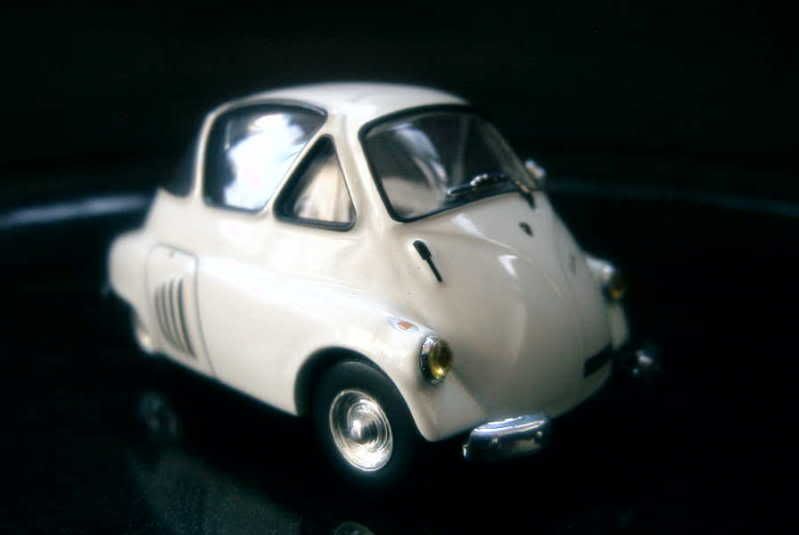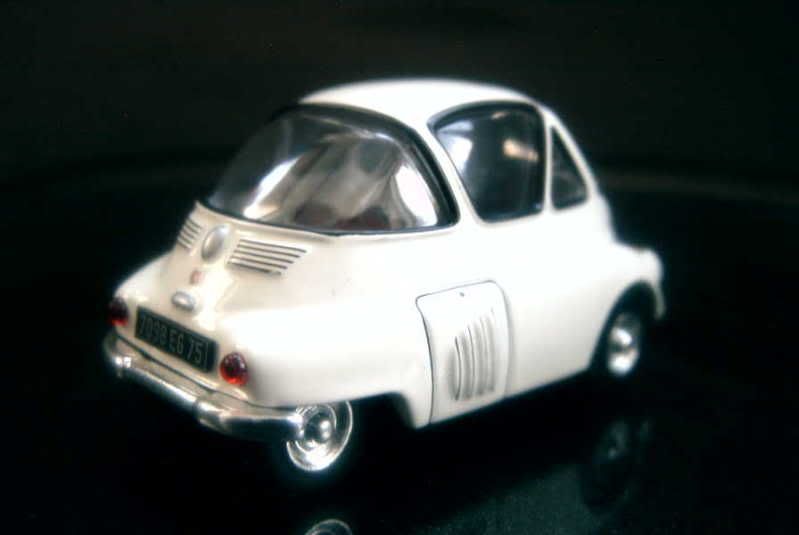A little history
Lamborghini made tractors before starting the production of its very first GT; as for itself Iso initially built refrigerators but didn’t graduate directly to Gran Turismo, passing through different stages instead, during which the Milanese company produced mopeds, then a popular four-wheel vehicle, the Isetta.
At first sight, the Isetta, a wheeled bubble that looked like nothing else on the road with its lone front door, could appear as a failure as it enjoyed a very limited production run in Italy: only a thousand built between the end of 1953 and 1955. However the diminutive Isetta, seating only two and devoid of differential – hence its very narrow rear gauge –, encountered a much more brilliant success outside the peninsula’s borders. Iso installed production lines in Spain, Belgium and Great Britain, and granted a license to Brazilian firm Romi. Slightly modified, the car was also built near Paris by Velam, but its main producer was to be the German company BMW. Nearly bankrupt owing to its unyielding battle with Mercedes-Benz for the control of the narrow luxury car market, the Bavarian firm was saved by the Isetta, produced at first in a virtually identical version which was progressively enhanced. The largest BMW model, the 600, was a stretched Isetta seating four. The last of the Isettas were built in 1962, when production of both the German and British versions of the car was stopped.
(This car’s history will be expanded in due time, please be patient.)
About the model
Model: Iso Isetta
Year: 1955
Maker: Ixo
Scale: 1/43
Distributed by: Altaya as no.75 of its Nos Chères Voitures d'Antan press series
Acquired: brand new, in April 2007, in Souillac, France
A nice model overall, this Isetta is nonetheless another lazy attempt by Altaya to maintain its Voitures d’Antan series alive for as long as possible – see what has already been said about the Ford Anglia to get the whole picture. Again the Isetta made sense among the original Spanish collection, but is totally meaningless after it travelled across the Pyrenees. To fulfil its promise Altaya would have done well by distributing a scale model of the Velam in France, but the simple change of headlights – they were separated from the body on the French version of the Isetta – required (minor) modifications to the mould and as a consequence induced costs that the Spanish distributor simply refused to bear. Well, there are many reasons for the relative low cost of the press series versus genuine Ixo models, and the sacrifice by its customers of Altaya’s respect towards them seems to be one of those. Strictly focussing on this model’s intrinsic qualities, I’ll penalize it for nothing else than bearing an irrational Parisian registration and still award it a decent 11/20.



Lamborghini made tractors before starting the production of its very first GT; as for itself Iso initially built refrigerators but didn’t graduate directly to Gran Turismo, passing through different stages instead, during which the Milanese company produced mopeds, then a popular four-wheel vehicle, the Isetta.
At first sight, the Isetta, a wheeled bubble that looked like nothing else on the road with its lone front door, could appear as a failure as it enjoyed a very limited production run in Italy: only a thousand built between the end of 1953 and 1955. However the diminutive Isetta, seating only two and devoid of differential – hence its very narrow rear gauge –, encountered a much more brilliant success outside the peninsula’s borders. Iso installed production lines in Spain, Belgium and Great Britain, and granted a license to Brazilian firm Romi. Slightly modified, the car was also built near Paris by Velam, but its main producer was to be the German company BMW. Nearly bankrupt owing to its unyielding battle with Mercedes-Benz for the control of the narrow luxury car market, the Bavarian firm was saved by the Isetta, produced at first in a virtually identical version which was progressively enhanced. The largest BMW model, the 600, was a stretched Isetta seating four. The last of the Isettas were built in 1962, when production of both the German and British versions of the car was stopped.
(This car’s history will be expanded in due time, please be patient.)
About the model
Model: Iso Isetta
Year: 1955
Maker: Ixo
Scale: 1/43
Distributed by: Altaya as no.75 of its Nos Chères Voitures d'Antan press series
Acquired: brand new, in April 2007, in Souillac, France
A nice model overall, this Isetta is nonetheless another lazy attempt by Altaya to maintain its Voitures d’Antan series alive for as long as possible – see what has already been said about the Ford Anglia to get the whole picture. Again the Isetta made sense among the original Spanish collection, but is totally meaningless after it travelled across the Pyrenees. To fulfil its promise Altaya would have done well by distributing a scale model of the Velam in France, but the simple change of headlights – they were separated from the body on the French version of the Isetta – required (minor) modifications to the mould and as a consequence induced costs that the Spanish distributor simply refused to bear. Well, there are many reasons for the relative low cost of the press series versus genuine Ixo models, and the sacrifice by its customers of Altaya’s respect towards them seems to be one of those. Strictly focussing on this model’s intrinsic qualities, I’ll penalize it for nothing else than bearing an irrational Parisian registration and still award it a decent 11/20.






No comments:
Post a Comment